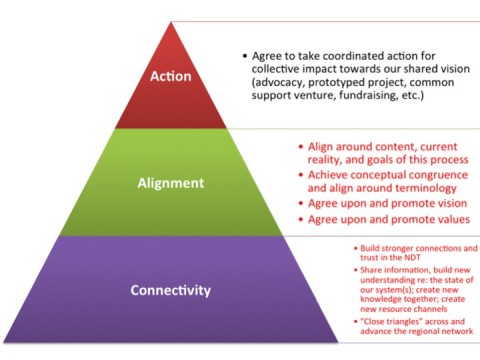Networking the Divide
June 19, 2013 Leave a comment I recently had an email exchange with someone who was reflecting on the difficulty of bridging the divides in a nascent network in the southern United States that is trying to tackle the local food system. Trying to reconcile differences (owing to diversity in functional lens, experience, generational perspective, social location, etc.) around a topic this vast can be very challenging. And I think this is precisely why networks are especially good mechanisms, and why adopting the “network mindset” is an excellent approach, moving forward, especially when borrowing from the framework above (adapted from Plastrik and Taylor’s work, 20o6).
I recently had an email exchange with someone who was reflecting on the difficulty of bridging the divides in a nascent network in the southern United States that is trying to tackle the local food system. Trying to reconcile differences (owing to diversity in functional lens, experience, generational perspective, social location, etc.) around a topic this vast can be very challenging. And I think this is precisely why networks are especially good mechanisms, and why adopting the “network mindset” is an excellent approach, moving forward, especially when borrowing from the framework above (adapted from Plastrik and Taylor’s work, 20o6).
Trying to coordinate action right out of the gate can be particularly tricky when the gulf in focus is wide, trust low, and risk of misunderstanding high. What can ensue in the rush to “do something,” is efforts to “solve for solution” or fight it out over whose approach or analysis is best. So just trying to create more connectivity through coming together, learning from and about one another and getting curious about the larger system of which we are a part, and perhaps sharing aspirations, can be less threatening and polarizing. Up a level from that, engaging in more alignment work, even around a shared aspirational vision and some common values can be useful and possible, especially with more trust in place. This is about establishing rules or formal obligations, which can heighten fear of and resistance to commitment, so much as common principles. Achieving this can be very encouraging and give people a deeper sense of shared intent. Then it almost seems natural that people start asking, “So what more could we do together?” I’m experiencing this in a big way right now in a couple of networks embedded in systems that are otherwise characterized by silos and a tendency to shy away from collective thinking. As people feel more connected and aligned, the thought of collective action becomes much more inviting and its potential impact that much greater and long lasting.